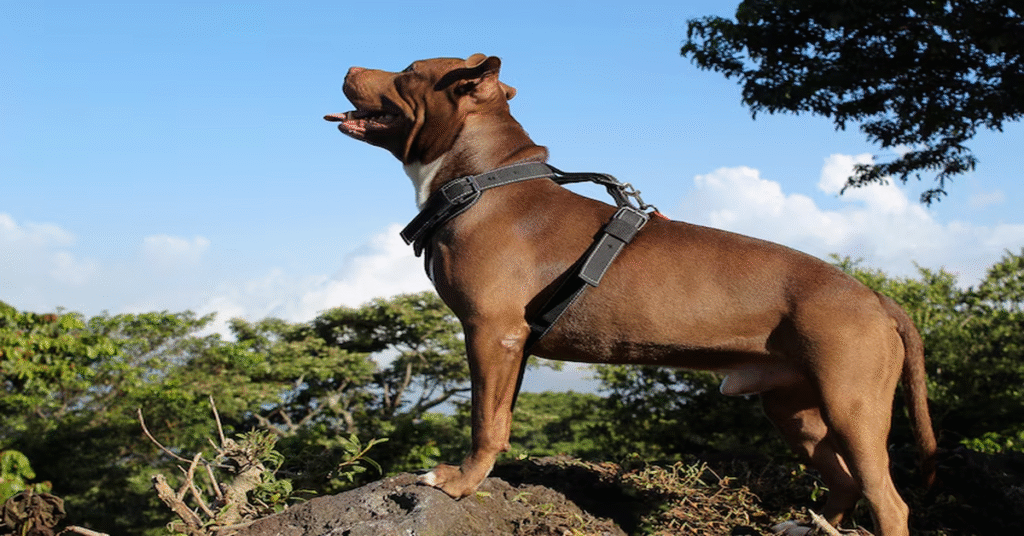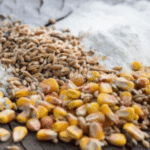The Black Mouth Cur is a rugged, intelligent, and versatile breed deeply woven into the fabric of American frontier history. Known for its loyalty, endurance, and unyielding work ethic, this dog is not just a pet but a partner in the truest sense. Originating in the Southern United States, the Black Mouth Cur is a hunting, herding, and guarding dog all rolled into one.
Whether used on farms, in forests, or as a family protector, the breed exemplifies the traits of strength, courage, and devotion. In this article, we’ll dive deep into the Black Mouth Cur’s origins, physical traits, temperament, care needs, and more.
Historical Background
Origins in the American South
The Black Mouth Cur traces its roots to the Southern United States, particularly in regions like Texas, Mississippi, Alabama, and Tennessee. The breed developed to fulfill the rigorous demands of early settlers who needed dogs capable of hunting game, protecting property, and herding livestock.
Unlike many modern breeds that were developed for show or specific aesthetic qualities, the Black Mouth Cur was bred for function over form. Its bloodline is thought to be a mix of various European cur-type dogs brought by settlers, resulting in a dog built for work and survival.
Evolution Through Utility
The dog’s name comes from one of its distinguishing features: a dark or black mask around the mouth. These dogs were not recognized by formal breed registries for many years because they were seen more as tools than pedigree pets. However, the United Kennel Club (UKC) and other organizations eventually recognized the breed due to its popularity and usefulness.
Physical Characteristics
General Appearance
The Black Mouth Cur has a muscular, athletic body built for strength and stamina. Their overall look is one of practicality, capable of moving swiftly across rugged terrain and holding their own in a scuffle with wild game.
- Height: 16 to 25 inches at the shoulder
- Weight: 40 to 95 pounds, depending on sex and lineage
- Coat: Short, dense, and coarse to protect from the elements
- Color: Ranges from yellow, fawn, brindle, red, and black, often with a distinctive black muzzle
Head and Facial Features
The head is broad with a strong jaw, alert eyes, and ears that may be floppy or semi-erect. Their expression is intelligent, focused, and always on high alert. The muzzle is proportionate to the skull, and the black mouth (or pigmentation) gives the breed its name.
Tail and Limbs
The tail is typically medium to long and may be natural or docked. Their legs are powerful and well-muscled, contributing to their speed and agility.
Temperament and Personality
Loyal and Protective
One of the most defining traits of the Black Mouth Cur is its deep loyalty to its family. This dog bonds intensely with its human companions and is known to guard them fiercely if it perceives a threat.
Intelligent and Trainable
This breed is highly intelligent and can pick up commands and cues quickly. However, its intelligence also means it requires mental stimulation and a firm, confident owner. Black Mouth Curs do best with consistent training and boundaries.
Energetic and Driven
As a working breed, the Black Mouth Cur possesses endless energy and a strong drive to perform tasks. Whether herding livestock, hunting, or patrolling a property, they prefer to be busy. A bored Cur can become destructive or anxious.
Sociability and Behavior with Children
Despite their toughness, they are often gentle and protective with children when properly socialized. They can be wary of strangers and other animals, so early training and exposure are crucial.
Working Capabilities
Hunting Skills
Black Mouth Curs are natural hunters, capable of tracking and treeing game like squirrels, raccoons, and wild boars. Their tenacity and courage make them ideal for dangerous tasks, and they are often used in hog hunting in Southern states.
Herding and Farm Work
This breed also excels at herding livestock, especially cattle and pigs. Their instinct, intelligence, and drive enable them to handle livestock with minimal instruction.
Guarding and Property Protection
Thanks to their territorial instincts, they are excellent guard dogs. They bark only when necessary, making them trustworthy protectors without being a nuisance.
Training and Socialization
Early Training is Key
Start training as early as 8 to 10 weeks old. Use positive reinforcement, such as treats, praise, and playtime, to keep the dog motivated. Harsh corrections can lead to fear or stubbornness in this sensitive yet strong-willed breed.
Commands and Skills
Essential commands for a Black Mouth Cur include:
- Sit
- Stay
- Come
- Heel
- Leave it
- Down
Advanced commands for herding or hunting should be introduced gradually once basic obedience is solid.
Socialization Techniques
Expose your Black Mouth Cur to various:
- People
- Animals
- Environments
- Sounds
This helps reduce wariness or aggression and builds confidence. Puppy classes and structured group training can also be helpful.
Care and Maintenance
Exercise Needs
These dogs require at least 60 to 90 minutes of vigorous activity every day. Good activities include:
- Running
- Fetch
- Agility training
- Hiking
- Farm chores
Without proper exercise, they may develop behavioral issues.
Diet and Nutrition
Feed a high-protein diet appropriate for active dogs. Choose food with real meat as the first ingredient and avoid fillers like corn or soy. Puppies, adults, and senior dogs all have different dietary needs, so adjust accordingly.
Recommended feeding schedule:
- Puppies: 3–4 meals/day
- Adults: 2 meals/day
- Seniors: 2 smaller meals/day
Grooming Requirements
The Black Mouth Cur’s short coat is easy to maintain:
- Brushing: Once a week with a firm bristle brush
- Bathing: Only when dirty
- Nail trimming: Monthly
- Ear cleaning: Weekly
- Dental hygiene: 2–3 times per week
Health and Lifespan
Typical lifespan: 12 to 16 years
Common health concerns:
- Hip dysplasia
- Ear infections
- Obesity (if not exercised adequately)
- Eye issues in older age
Routine vet check-ups and vaccinations are crucial to maintaining good health.
Living Environment
Rural vs. Urban Living
The Black Mouth Cur is best suited for rural or suburban environments where it has room to roam and tasks to do. Apartments or small homes without yards are not ideal.
Fencing and Safety
Always ensure your yard is securely fenced. Their high prey drive may cause them to chase small animals or try to escape in pursuit.
Indoor Behavior
While not typically indoor lapdogs, Black Mouth Curs can adapt to family life inside the home as long as they receive adequate exercise. They are not prone to excessive barking and can be quite calm indoors.
Breeding and Puppies
Choosing a Breeder
Choose a responsible breeder who screens for genetic conditions and prioritizes temperament and health over appearance. Avoid puppy mills or breeders who can’t provide medical and socialization records.
Litter Size and Puppy Traits
Typical litter size: 4 to 10 puppies
Black Mouth Cur puppies are:
- Playful
- Curious
- Energetic
- Quick learners
Raising a Puppy
Key stages in puppy development:
- 8–12 weeks: Crate training and housebreaking
- 3–6 months: Basic commands and leash training
- 6–12 months: Advanced training and socialization
Recognition and Breed Status
Breed Organizations
The Black Mouth Cur is recognized by:
- United Kennel Club (UKC)
- National Kennel Club (NKC)
- American Canine Association (ACA)
It is not currently recognized by the American Kennel Club (AKC), primarily due to its regional nature and functional origins.
Breed Standards
UKC standards typically emphasize:
- Balanced proportions
- Functional build
- Appropriate temperament
- Working ability over physical perfection
Popularity and Cultural Significance
Representation in Media
The Black Mouth Cur gained mainstream attention from the beloved novel and film “Old Yeller”, in which the titular dog is believed to be a Cur. This portrayal enhanced its image as a loyal, brave family companion.
Modern Roles
Today, Black Mouth Curs are:
- Farm dogs
- Hunting companions
- Search-and-rescue dogs
- Family guardians
They are less common in urban areas but are gaining recognition among outdoor enthusiasts and working dog lovers.
Conclusion
The Black Mouth Cur is a breed that embodies the spirit of the American frontier—resilient, intelligent, and deeply loyal. More than just a dog, it’s a working companion, a guardian, and a beloved family member. Its natural talents in hunting, herding, and protecting make it a versatile asset for any household, especially those with space and structure.
For those willing to invest time in training and care, the Black Mouth Cur offers unmatched devotion and capability. It’s not a breed for everyone, but for the right person, it’s a partner for life.
FAQs
1. Is the Black Mouth Cur good with kids?
Yes, with proper socialization, they are affectionate and protective of children, often forming strong bonds with family members.
2. How much exercise does a Black Mouth Cur need?
At least 60–90 minutes of vigorous activity daily is ideal to prevent behavioral problems and keep them healthy.
3. Can Black Mouth Curs live in apartments?
They are not suited for apartments. They need space to move and tasks to stay mentally stimulated.
4. Are they aggressive dogs?
They are not inherently aggressive but can be territorial or wary of strangers if not socialized properly.
5. Do Black Mouth Curs get along with other pets?
Early and consistent socialization is key. They may have a high prey drive, so supervision is necessary with smaller animals.
6. Are Black Mouth Curs easy to train?
Yes, they are intelligent and eager to please, but they require firm, consistent training and plenty of mental stimulation.







